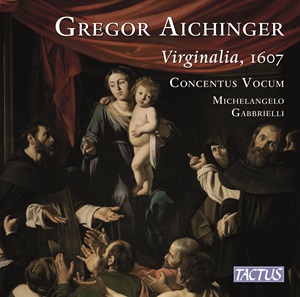
Gregor Aichinger (1564-1628)
Virginilia, 1607
Riccardo Quadri (organ), Concentus Vocum/Michelangelo Gabbrielli
rec. 2019, Chiesa dei Santi Giordiano ed Epimaco, Blevio, Italy
Tactus TC 560101 [53]
Fifty years ago, I found in a junk shop copies of Gregor Aichinger’s joyous motet Factus est repente. My church choir tried it, and enjoyed it a lot. It became a staple of our Whitsun repertoire.
The disc presents Aichinger’s one publication, in which each brief motet begins with Virgo. The motets are interspersed with pieces by Andrea Gabrieli and his nephew Giovanni, and the keyboard works are placed to correspond with the modes of the motets. That is no accident. Aichinger, born probably in Regensburg, was sponsored to study in Venice with Andrea – who, it seems, regarded him very highly – and after his death in 1585 with Giovanni. Aichinger then moved to Rome, where devotion to the Virgin Mary was at a height when he published his Marian motets. If the choir’s director and booklet writer Michelangelo Gabbrielli is correct, he also composed them there.
Aichinger went on to study in Siena, where Adriano Banchieri regarded him very highly. So, he was a composer of some significance, respected in his lifetime, but his music is now almost entirely forgotten.
Aichinger’s musical style is varied. A piece may sound like a canzonetta or a madrigal, it can be homophonic (as in Virgo, cuius sanctum) or imitative (as in Virgo, quae triumphantem filium). His music is often very expressive, and one might feel the influence of the forthcoming Baroque style. I can do no better than quote, with thanks, from the booklet: “The Virginalia consist of twenty five-part pieces. The introductory one, Virgo, Dei mater pura, is followed by the motets of the Joyful Mysteries (from the second to the sixth), then – from the seventh to the eleventh – by those of the Sorrowful Mysteries, and subsequently – from the twelfth to the sixteenth – by those of the Glorious Mysteries. In the last four pieces there is a contemplation of the Virgin Mary, by now projected in a light and a dimension that are beyond the world, as the mediator between mankind and God.”
Concentus Vocum, a choir of twelve women and twelve men, sounds fuller than I would expect but perhaps less precise in pitch and detail. Yet this suits the music with a warm tone and generous balance, even if the intonation is not always reliable. The acoustic is ideal, and the church itself is wondrously set beside Lake Como.
For texts, Tactus sends us here.
Gary Higginson
Help us financially by purchasing from


Contents
All pieces by Aichinger, except those marked AG or GG, for Andrea Gabrieli (1533-1585) and Giovanni Gabrielli (1564-1612).
Toccata dell’ottavo tono [AG]
Virgo, Dei Mater pura
Ricercare dell’ottavo [AG]
Virgo, quæ salutata
Virgo, quæ charitate ardent
Virgo, Mater benigna
Virgo, quæ tuum Natum
Virgo, cui post dolores
Toccata del secondo tono [GG]
Virgo, quæ benedictum filium tuum
Virgo, quæ dulcis nati
Virgo, quæ caput sanctum
Virgo, cuius dilectus filius
Virgo, quæ clavis nudum
Fuga del settimo tono [GG]
Virgo, quæ prima sole
Virgo, quæ triumphantem filium
Virgo, quæ comitata Apostolis
Virgo, cuius in coelum anima assumpta fuit
Virgo, quæ coronata a Sancta Trinitate
Toccata [attributed to GG]
Virgo, coeli Regina
Virgo, sole vestita
Virgo, cuius stat luna sub pedibus
Virgo, sublime exemplum
Toccata [GG]

















